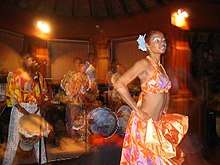Music of Mauritius

The traditional music of Mauritius is known as sega music, though reggae, zouk, soukous and other genres are also popular. Well-known traditional sega singers from Mauritius include Ti Frére, Marlene Ravaton, Serge Lebrasse, Michel Legris and Fanfan.
Musicians in Mauritius are very talented and through the years Mauritian Music has evolved to international standards. There are many jazz and Blues Artists around the Island.
Sega, Seggae and Reggae remain the most popular produced Music in Mauritius amongst Mauritian artists. Thanks to a decent Internet connection nowadays we see more evolved artists doing RnB, Hip-Hop, Soul, Dubstep, Club, Techno and other worldwide known music.
The Sega is usually sung in Creole (mother tongue of Mauritians). Many singers had thought of also bringing forward the English version of the Sega songs but later resolved not to proceed with it so as to preserve the uniqueness and cultural richness of the local music of Mauritius.
The original instruments are fast disappearing, making way for the more conventional orchestra ensemble. However, all along the coastal fishing villages, the traditional instruments such as the “Ravanne”, “Triangle”, the “Maravanne” and the traditional guitar are still being used.
By 2015, some of the most known Mauritian sega artists were - Alain Ramanisum, Desiré Francois, Ziakazom. Other top known Mauritian artists are Zulu and The Prophecy.
Sega
The sega is one of the most popular form of music and dance of Mauritius. The traditional instrumentation includes the ravann, a goat-skin covered drum, the triangle, and the maravann.
It is not clear when sega originated. Most claim that sega music and dance origins are found in the slavery epoch, but research has not established this as a fact. Nowadays, Mauritians sing sega as a form of self-expression. Rural forms of music include Mauritian bhojpuri songs, kawals, that date from the epoch of indentured labour and remained popular in Mauritian villages but are now fast disappearing.
There have been many groups that have been formed that fuse these two as well as others that have a deeper connection to the roots of each genre. Cassiya is an example of a group that has become popular not only in Mauritius but also in the neighboring islands such as Reunion. Their single "Mo fami Peser" gives us an idea of how life has evolved for the black indentured laborer post-slavery. It tells about how life as a fisherman becomes more difficult as the seas become more polluted and even though they tried to find a normal city job, they still prefer peaceful life of a fisherman. It remains one of their most successful and loved singles.
Asian music in Mauritius
Indian immigrants have brought many of their own styles of music and dance, along with instruments like the sitar and tabla. Mauritian-based Bhojpuri music has always been popular with people of Indian-descent, but is now gaining mainstream appeal through the work of artists such as The Bhojpuri Boys and Neeraj Gupta Mudhoo. Their fusion of bhojpuri lyrics, sega beats, and more traditional Indian, as well as Bollywood-style, music has won the hearts of many Mauritians and given rise to major hits such as "Langaroo" (by The Bhojpuri Boys). Chinese immigrants have also infused Mauritian culture with elements from distinctly Chinese musical traditions.
Rock music in Mauritius
Rock music has recently become very popular in Mauritius, many bands have become famous, including XBreed Supersoul, Skeptikal, and Reborn Orlean which is nearer to metal/hard rock.
Musical groups and singers
A list of notable musical groups and singers from Mauritius.
Groups
|
* Steel Grooving band
|
Singers
|
|
See also
- Sega music
- Seggae
- Santé engagé
- Category:Mauritian singers
- Category:Mauritian musicians
- Category:Mauritian musical instruments
References
- Ewens, Graeme and Werner Graebner. "A Lightness of Touch". 2000. In Broughton, Simon and Ellingham, Mark with McConnachie, James and Duane, Orla (Ed.), World Music, Vol. 1: Africa, Europe and the Middle East, pp 505–508. Rough Guides Ltd, Penguin Books. ISBN 1-85828-636-0
.svg.png)